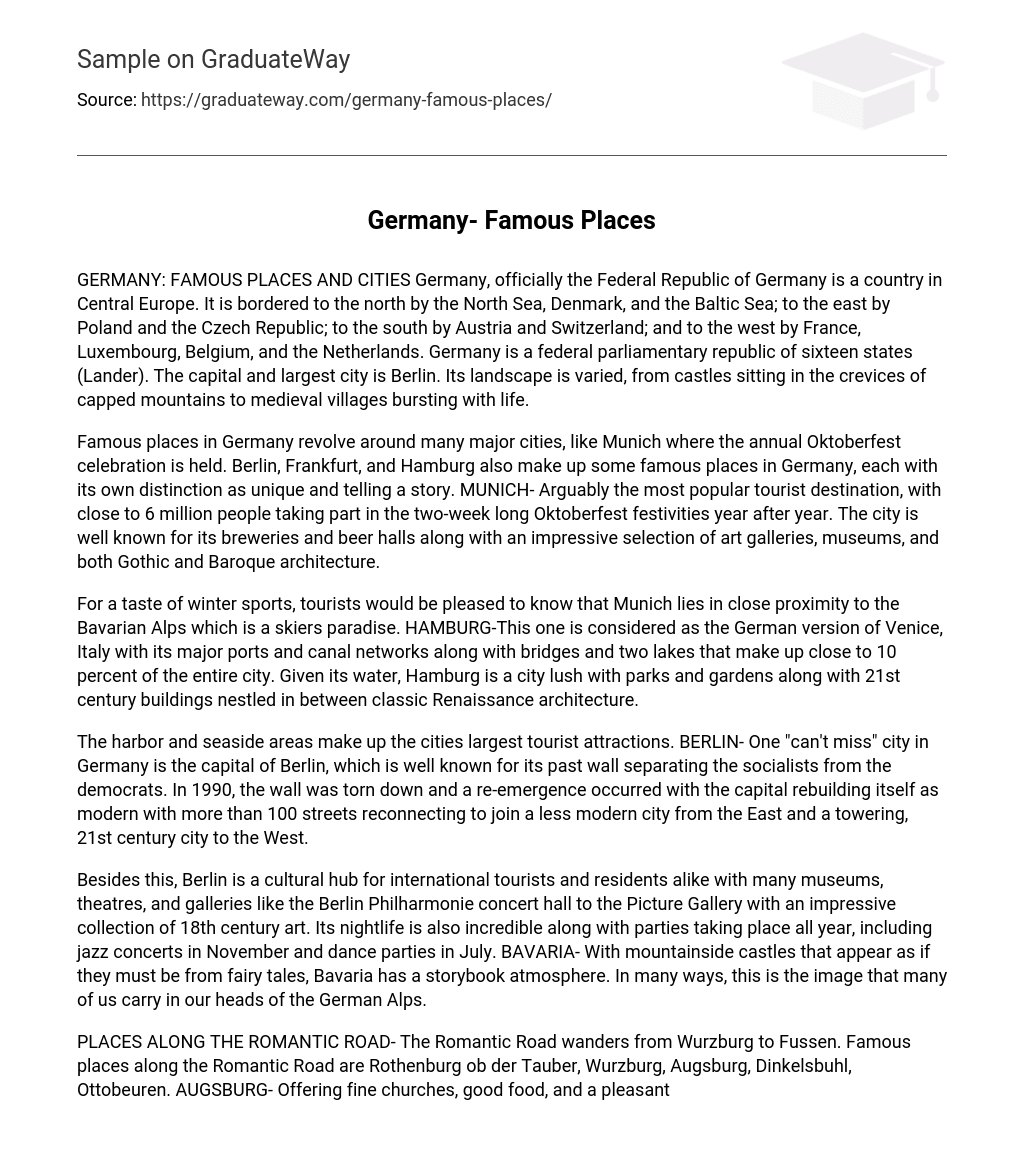Germany, officially the Federal Republic of Germany is a country in Central Europe. It is bordered to the north by the North Sea, Denmark, and the Baltic Sea; to the east by Poland and the Czech Republic; to the south by Austria and Switzerland; and to the west by France, Luxembourg, Belgium, and the Netherlands. Germany is a federal parliamentary republic of sixteen states (Lander). The capital and largest city is Berlin. Its landscape is varied, from castles sitting in the crevices of capped mountains to medieval villages bursting with life.
Famous places in Germany revolve around many major cities, like Munich where the annual Oktoberfest celebration is held. Berlin, Frankfurt, and Hamburg also make up some famous places in Germany, each with its own distinction as unique and telling a story. Arguably the most popular tourist destination, with close to 6 million people taking part in the two-week long Oktoberfest festivities year after year. The city is well known for its breweries and beer halls along with an impressive selection of art galleries, museums, and both Gothic and Baroque architecture.
For a taste of winter sports, tourists would be pleased to know that Munich lies in close proximity to the Bavarian Alps which is a skiers paradise. This one is considered as the German version of Venice, Italy with its major ports and canal networks along with bridges and two lakes that make up close to 10 percent of the entire city. Given its water, Hamburg is a city lush with parks and gardens along with 21st century buildings nestled in between classic Renaissance architecture.
The harbor and seaside areas make up the cities largest tourist attractions. One “can’t miss” city in Germany is the capital of Berlin, which is well known for its past wall separating the socialists from the democrats. In 1990, the wall was torn down and a re-emergence occurred with the capital rebuilding itself as modern with more than 100 streets reconnecting to join a less modern city from the East and a towering, 21st century city to the West.
Besides this, Berlin is a cultural hub for international tourists and residents alike with many museums, theatres, and galleries like the Berlin Philharmonie concert hall to the Picture Gallery with an impressive collection of 18th century art. Its nightlife is also incredible along with parties taking place all year, including jazz concerts in November and dance parties in July. With mountainside castles that appear as if they must be from fairy tales, Bavaria has a storybook atmosphere. In many ways, this is the image that many of us carry in our heads of the German Alps.
The Romantic Road wanders from Wurzburg to Fussen. Famous places along the Romantic Road are Rothenburg ob der Tauber, Wurzburg, Augsburg, Dinkelsbuhl, Ottobeuren. AUGSBURG- Offering fine churches, good food, and a pleasant location, Augsburg is one of the best known towns on the Romantic Road. It offers interesting museums (including the Roman Museum and the Maximillian Museum) and several attractive historical buildings. Rathaus[city hall] can also be termed as an important attraction.
Although severely damaged in World War II, this beautiful building has now been restored to its former glory. Considered by many to be the most desirable and authentic medieval town on the “Romantik Strasse” (the Romantic Road), Rothenburg is the prototypical walled town with dramatic architecture, good food, and great trinket shopping. Many complain that Rothenburg is too touristy, but it is universally acclaimed as the best example of a medieval town in Germany. The town is, also, known for its “Christmas Market”.
Once an important medieval center and a historic university town, Wurzburg is located in a noted wine growing region and offers a pleasant some important places are the Princebishops Palace (the Residence (Residenz)) and the Court Garden. The Fortress (Festung) Marienberg is worth a stop. Finally, the city has an amazing collection of historic churches that exhibit dramatic architectures. Heidelberg is one of the few German cities that wasn’t destroyed in World War II; plenty of old world charm fills the narrow cobble stone streets of its Old Town, which was the center for Germany’s romantic period.
The ruins of the once grand Heidelberg castle, the oldest university in the country, and the idyllic river valley make Heidelberg one of the most picturesque destinations in Germany. Dresden, spread out on both banks of the river Elbe in Saxony, is also called “Florence at the Elbe”, due to its idyllic location, excellent examples of baroque architecture, and world-renowned art treasures. Although 80% of Dresden’s historic center was destroyed in World War II, all landmarks have been rebuilt to their former splendor.
Potsdam, a short distance from Berlin, is the historic heart of the Prussian Empire and played a key role in the history of Europe. Although the city suffered through the last half of the 20th century, Potsdam is beginning to reassume its leading role in Germany’s cultural and historic heritage. Its a UNESCO World Heritage site, is known for many things, but the most interesting attractions are its parks, palaces, historic architecture, and gardens. Schloss Sanssouci in Potsdam was the summer residence of Frederick the Great and is considered a landmark of world architecture.
Potsdam has several historic districts and neighborhoods that uniquely reflect this famous city’s role in pan-European history. Germany truly a land of thousand possibilities feels proud to have some of the world famous cities n places in the world, its architectural splendor in form of abbeys and castles, medieval villages, wine flowing countryside are the major attraction. In all Germany is a beautiful country with an endless list of splended cities and places that even the world





